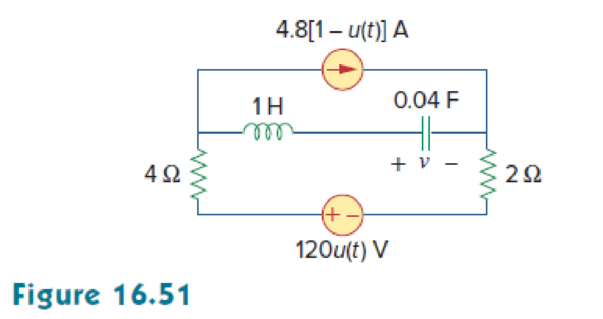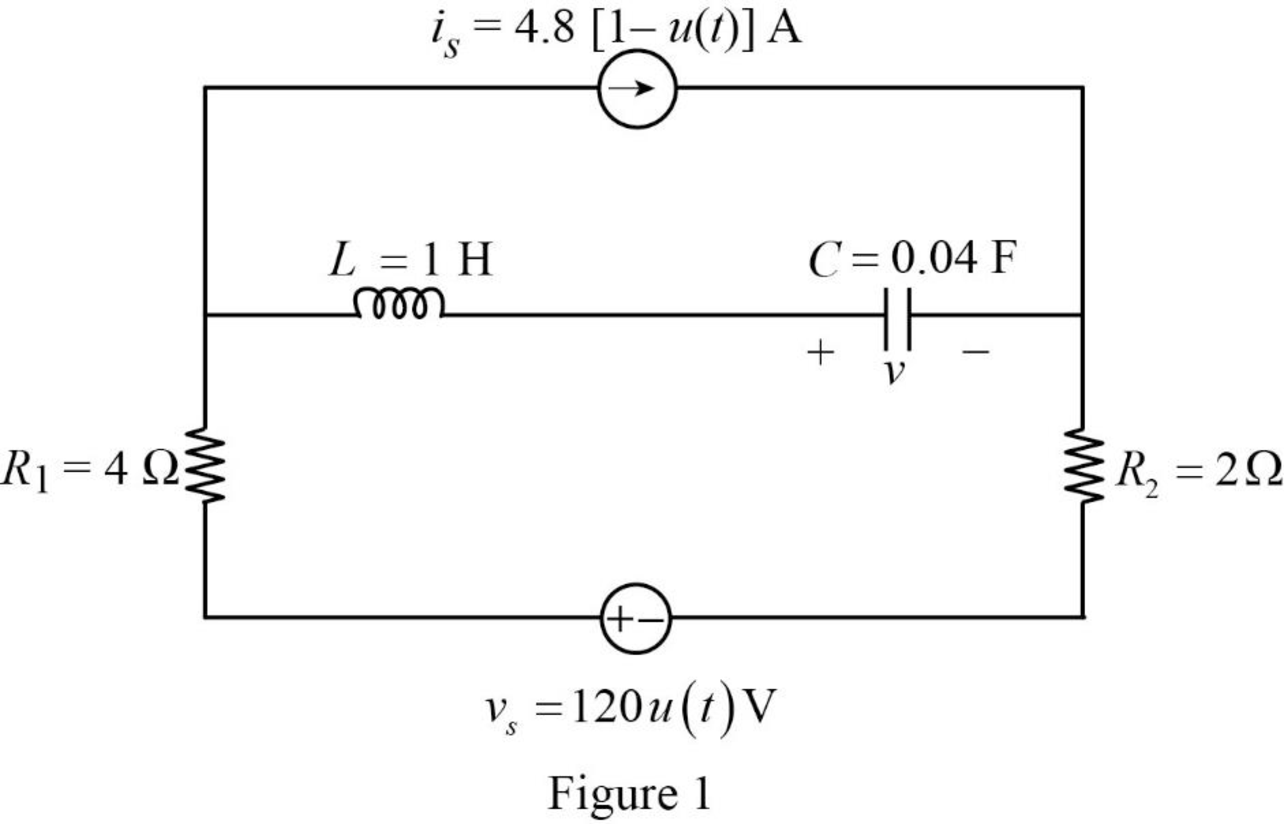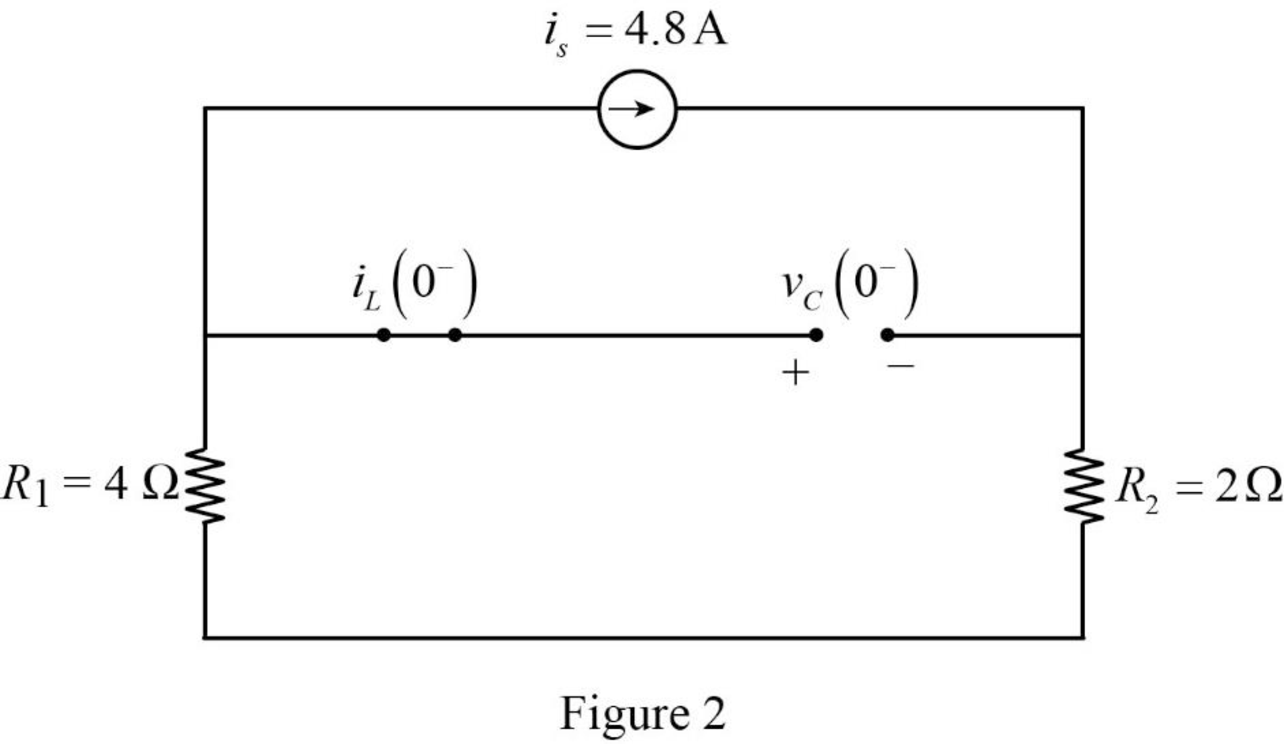
For the circuit in Fig. 16.51, find v(t) for t > 0.

Find the expression of voltage
Answer to Problem 28P
The expression of voltage
Explanation of Solution
Given data:
Refer to Figure 16.51 in the textbook.
Formula used:
Write an expression to calculate the value of step input.
Write a general expression to calculate the impedance of a resistor in s-domain.
Here,
Write a general expression to calculate the impedance of an inductor in s-domain.
Here,
Write a general expression to calculate the impedance of a capacitor in s-domain.
Here,
Calculation:
The given circuit is redrawn as shown in Figure 1.

For a DC circuit, at steady state condition when time
The value of current source is calculated as follows:
The value of voltage source is calculated as follows:
Since the value of voltage source is zero it is short circuited.
Now, the Figure 1 is reduced as shown in Figure 2.

Refer to Figure 2, the capacitor is connected in parallel with the series connected resistors
Refer to Figure 2, since the capacitor is open circuited there is no current flow through the inductor.
The current through inductor and voltage across capacitor is always continuous so that,
For time
The value of current source is calculated as follows:
Since the value of current source is zero it is open circuited.
Now, the Figure 1 is reduced as shown in Figure 3.

Substitute
Substitute
Substitute
Substitute
Apply Laplace transform for
Using element transformation methods with initial conditions convert the Figure 3 into s-domain.

Apply Kirchhoff’s voltage law for the circuit shown in Figure 4.
Substitute
Simplify the above equation to find
From the equation (4), the characteristic equation is
Write a general expression to calculate the roots of quadratic equation
Comparing the equation (5) with the equation
Substitute
Simplify the above equation to find
Substitute the roots of characteristic equation in equation (4) to find
Refer to Figure 4, the voltage
Substitute
Assume,
Substitute equation (8) in equation (7).
Take partial fraction for equation (8).
The equation (10) can also be written as follows:
Simplify the above equation as follows:
Substitute
Simplify the above equation to find
Substitute
Simplify the above equation to find
Substitute
Simplify the above equation to find
Substitute
Substitute
Apply inverse Laplace transform for above equation to find
Simplify the above equation to find
Conclusion:
Thus, the expression of voltage
Want to see more full solutions like this?
Chapter 16 Solutions
FUNDAMENTALS OF ELEC.CIRC.(LL) >CUSTOM<
- A system whose dynamic equations dx(t)/dt = Ax(t) + Bu(t) y(t) = Cx(t) are given as . Find the eigenvalues of A. Find the transfer relationship between X(s) and U(s). Find the Y (s)/ U(s) transfer function.arrow_forwardIf the transfer function V2(s) / V1(s) = s / s^2+5s+4, then find the Z. (It may contain R,L,C components). ..arrow_forwardQ/ Implement the following P.O.S function (A,B,C,D)=sum(1,5,8,9,12,13,15) using MUX's of 3*8. *arrow_forward
- Which of the following is the H (s) transfer function of the system whose block diagram is given? s / (4s + 3)4 s / (3s + 1)4 s / (3s + 2)s / (s + 4)4 s / (s + 1)3 s / (s + 4)arrow_forwardFind the transfer function, G(s) = X3(s) / F(s), for the translational mechanical networkarrow_forwardUSE THE CIRCUITS IN THE S-DOMAIN, The circuit parameters in the circuit are R=500Ω,L=250mH, and C=250nF. find If Idc=5mA, find io(t)for t≥0.arrow_forward
- Express the complement of the following function in sum of minterms: F(x,y,z) = ∏(0,3,6,7)arrow_forwardThe input-output relation for a system is given as y(n)=4x(n-2). Find out the transfer function of the system.arrow_forward2. Write the mathematical equations for the mechanical system given. Also find the transfer functions X1(s)/F(s) and X2(s)/F(s) of the given systemarrow_forward
- For a continuous time LTI system, the output is given as Y(s)=10(2s+3)/(s2+4s+5). Find out the final value of y(t) using final value theorem.arrow_forwardDerive complete analogy between series R L C circuit and rotational mechanical system parameterized by b, J, k Use MATLAB/Simulink to calculate Eigen values /Eigen Vectors of A= 1 -1 2 0 1 0 3 2 1arrow_forwardFind the transfer functions of electrical circuitsarrow_forward
 Introductory Circuit Analysis (13th Edition)Electrical EngineeringISBN:9780133923605Author:Robert L. BoylestadPublisher:PEARSON
Introductory Circuit Analysis (13th Edition)Electrical EngineeringISBN:9780133923605Author:Robert L. BoylestadPublisher:PEARSON Delmar's Standard Textbook Of ElectricityElectrical EngineeringISBN:9781337900348Author:Stephen L. HermanPublisher:Cengage Learning
Delmar's Standard Textbook Of ElectricityElectrical EngineeringISBN:9781337900348Author:Stephen L. HermanPublisher:Cengage Learning Programmable Logic ControllersElectrical EngineeringISBN:9780073373843Author:Frank D. PetruzellaPublisher:McGraw-Hill Education
Programmable Logic ControllersElectrical EngineeringISBN:9780073373843Author:Frank D. PetruzellaPublisher:McGraw-Hill Education Fundamentals of Electric CircuitsElectrical EngineeringISBN:9780078028229Author:Charles K Alexander, Matthew SadikuPublisher:McGraw-Hill Education
Fundamentals of Electric CircuitsElectrical EngineeringISBN:9780078028229Author:Charles K Alexander, Matthew SadikuPublisher:McGraw-Hill Education Electric Circuits. (11th Edition)Electrical EngineeringISBN:9780134746968Author:James W. Nilsson, Susan RiedelPublisher:PEARSON
Electric Circuits. (11th Edition)Electrical EngineeringISBN:9780134746968Author:James W. Nilsson, Susan RiedelPublisher:PEARSON Engineering ElectromagneticsElectrical EngineeringISBN:9780078028151Author:Hayt, William H. (william Hart), Jr, BUCK, John A.Publisher:Mcgraw-hill Education,
Engineering ElectromagneticsElectrical EngineeringISBN:9780078028151Author:Hayt, William H. (william Hart), Jr, BUCK, John A.Publisher:Mcgraw-hill Education,





